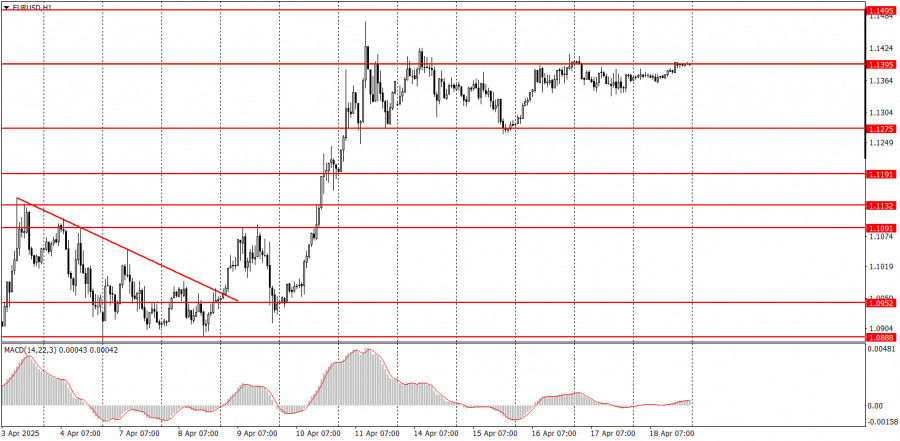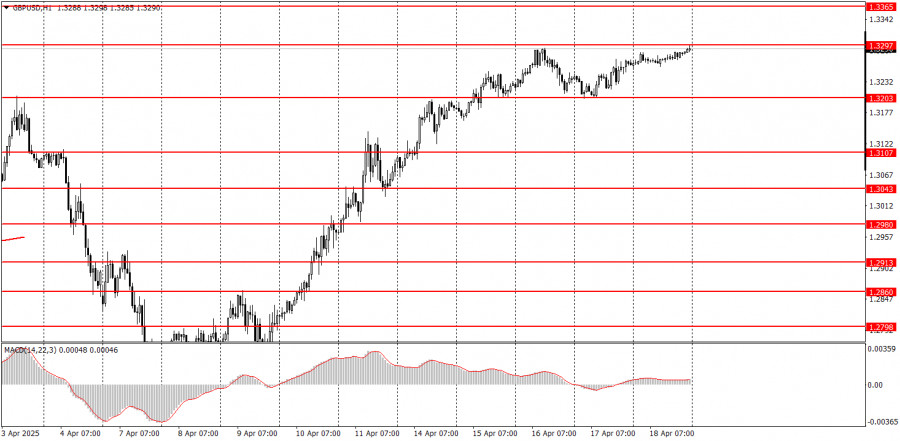See also


 21.04.2025 06:30 AM
21.04.2025 06:30 AMNo macroeconomic events are scheduled for Monday—not in the U.S., the Eurozone, Germany, or the U.K. Therefore, even if the market was paying attention to the macroeconomic backdrop, today, there is none. The market continues to trade solely on the "Trump factor." At least the euro is on a flat trend (waiting for news), while the British pound seems to be rising without any apparent reason or basis.
There is no point in discussing any fundamental events apart from Trump's trade war. The dollar's decline may continue indefinitely if Trump keeps imposing new tariffs or raising existing ones. We advise traders to pay close attention to the remarks of top officials from major countries and alliances regarding tariffs. Any escalation may trigger a new wave of dollar selling, while any signs of de-escalation could strengthen the greenback.
Last week, Donald Trump announced plans to impose tariffs on semiconductors, which affects many countries globally. The trade conflict with China remains unresolved and continues to be a top concern for the market. Additionally, Trump is once again pressuring the Federal Reserve to cut interest rates and has even threatened to fire Jerome Powell—although he does not have the authority to do so. On Wednesday evening, the Fed Chair stated that concrete macroeconomic grounds are required for a rate cut, which is currently absent. Trump is reportedly furious over this.
On the first trading day of the new week, both currency pairs could move in either direction. As we can see, the British pound is confidently rising while the euro remains flat. Any market-moving news today is likely to come only from the White House. If no statements come from Trump, then the current trading behavior of both currency pairs is unlikely to change.
Support and Resistance Levels: These are target levels for opening or closing positions and can also serve as points for placing Take Profit orders.
Red Lines: Channels or trendlines indicating the current trend and the preferred direction for trading.
MACD Indicator (14,22,3): A histogram and signal line used as a supplementary source of trading signals.
Important speeches and reports, which are consistently featured in the news calendar, can significantly influence the movement of a currency pair. Therefore, during their release, it is advisable to trade with caution or consider exiting the market to avoid potential sharp price reversals against the prior trend.
Beginners in the Forex market should understand that not every transaction will be profitable. Developing a clear trading strategy and practicing effective money management are crucial for achieving long-term success in trading.
You have already liked this post today
*The market analysis posted here is meant to increase your awareness, but not to give instructions to make a trade.
There are relatively few macroeconomic events scheduled for Thursday, but that no longer matters much. Yesterday, there were plenty of important publications from the Eurozone, Germany, and the U.S. Even
Markets are already fatigued by the chaos unfolding in Donald Trump's mind and among his followers. Everything remains extremely unclear, so market participants are now fully focused on today's important
Your IP address shows that you are currently located in the USA. If you are a resident of the United States, you are prohibited from using the services of InstaFintech Group including online trading, online transfers, deposit/withdrawal of funds, etc.
If you think you are seeing this message by mistake and your location is not the US, kindly proceed to the website. Otherwise, you must leave the website in order to comply with government restrictions.
Why does your IP address show your location as the USA?
Please confirm whether you are a US resident or not by clicking the relevant button below. If you choose the wrong option, being a US resident, you will not be able to open an account with InstaTrade anyway.
We are sorry for any inconvenience caused by this message.


